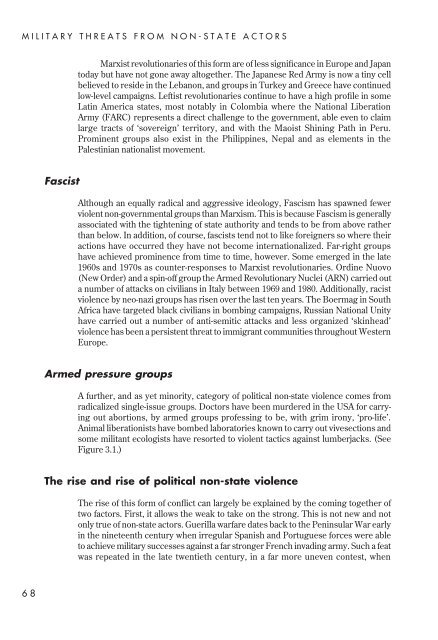Understanding global security - Peter Hough
Understanding global security - Peter Hough
Understanding global security - Peter Hough
Create successful ePaper yourself
Turn your PDF publications into a flip-book with our unique Google optimized e-Paper software.
MILITARY THREATS FROM NON-STATE ACTORS<br />
Marxist revolutionaries of this form are of less significance in Europe and Japan<br />
today but have not gone away altogether. The Japanese Red Army is now a tiny cell<br />
believed to reside in the Lebanon, and groups in Turkey and Greece have continued<br />
low-level campaigns. Leftist revolutionaries continue to have a high profile in some<br />
Latin America states, most notably in Colombia where the National Liberation<br />
Army (FARC) represents a direct challenge to the government, able even to claim<br />
large tracts of ‘sovereign’ territory, and with the Maoist Shining Path in Peru.<br />
Prominent groups also exist in the Philippines, Nepal and as elements in the<br />
Palestinian nationalist movement.<br />
Fascist<br />
Although an equally radical and aggressive ideology, Fascism has spawned fewer<br />
violent non-governmental groups than Marxism. This is because Fascism is generally<br />
associated with the tightening of state authority and tends to be from above rather<br />
than below. In addition, of course, fascists tend not to like foreigners so where their<br />
actions have occurred they have not become internationalized. Far-right groups<br />
have achieved prominence from time to time, however. Some emerged in the late<br />
1960s and 1970s as counter-responses to Marxist revolutionaries. Ordine Nuovo<br />
(New Order) and a spin-off group the Armed Revolutionary Nuclei (ARN) carried out<br />
a number of attacks on civilians in Italy between 1969 and 1980. Additionally, racist<br />
violence by neo-nazi groups has risen over the last ten years. The Boermag in South<br />
Africa have targeted black civilians in bombing campaigns, Russian National Unity<br />
have carried out a number of anti-semitic attacks and less organized ‘skinhead’<br />
violence has been a persistent threat to immigrant communities throughout Western<br />
Europe.<br />
Armed pressure groups<br />
A further, and as yet minority, category of political non-state violence comes from<br />
radicalized single-issue groups. Doctors have been murdered in the USA for carrying<br />
out abortions, by armed groups professing to be, with grim irony, ‘pro-life’.<br />
Animal liberationists have bombed laboratories known to carry out vivesections and<br />
some militant ecologists have resorted to violent tactics against lumberjacks. (See<br />
Figure 3.1.)<br />
The rise and rise of political non-state violence<br />
The rise of this form of conflict can largely be explained by the coming together of<br />
two factors. First, it allows the weak to take on the strong. This is not new and not<br />
only true of non-state actors. Guerilla warfare dates back to the Peninsular War early<br />
in the nineteenth century when irregular Spanish and Portuguese forces were able<br />
to achieve military successes against a far stronger French invading army. Such a feat<br />
was repeated in the late twentieth century, in a far more uneven contest, when<br />
68
















